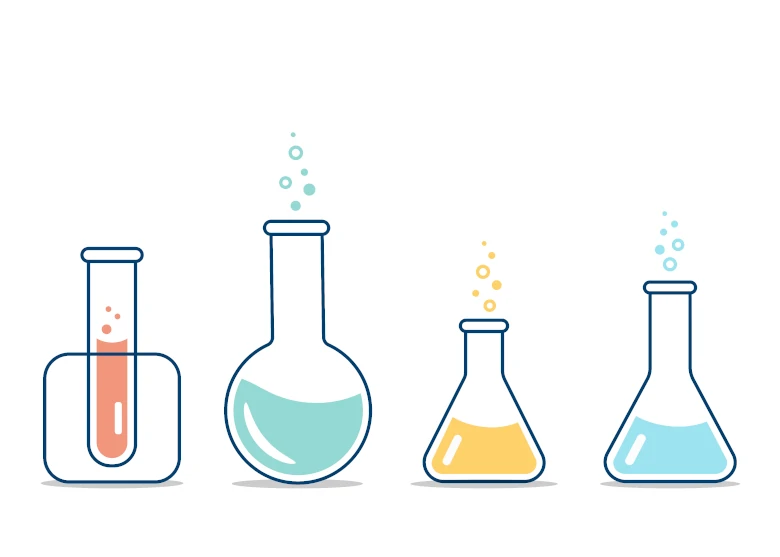Electrolysis
In this article, we are going to learn the basics of electrolysis. We will cover the following learning outcomes which are part of the syllabus of the Upper Secondary Chemistry:
- Describe electrolysis as the conduction of electricity by an ionic compound, when molten or dissolved in water, leading to its decomposition.
- Describe electrolysis as evidence for the existence of ions which are held in a lattice when solid but which are free to move when molten or in solution.
- Describe in terms of mobility of ions present and the electrode products, the electrolysis of molten sodium chloride, using inert electrodes.
- Predict the likely products of the electrolysis of a molten binary compound.
Introduction
Electrolysis is the process of using electricity to break down or decompose a compound. This compound is usually an ionic compound either in the molten state or in the aqueous solution.
Electrolytic Cell And Its Components
The electrolytic cell consists of three main components – battery, electrodes and electrolyte.
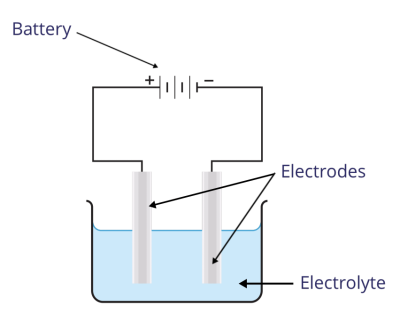
- Battery
The battery functions as the power source. It provides the electrical energy to bring about the chemical change, i.e., the decomposition of the ionic compound.
- Electrodes
Electrodes are electrical contacts that close or complete the electric circuit between the wires and the electrolyte.
- Examples of electrodes include carbon rods (graphite) and metal plates.
- The electrode on the left (refer to image above) that is connected to the positive terminal of the battery is the positive electrode or anode.
- The electrode on the right (refer to the image above) that is connected to the negative terminal of the battery is the negative electrode or cathode.
- Electrolyte
The electrolyte is a substance that contains mobile ions when molten or in aqueous solution, to conduct electricity.
- Examples of electrolytes include molten sodium chloride, copper(II) sulfate solution and acids, such as dilute hydrochloric acid.
- Examples of non−electrolytes include sugar solution, ethanol, (molten) sulfur, as these are liquids or solutions that do not contain mobile ions to conduct electricity.
How Does Electrolysis Work?
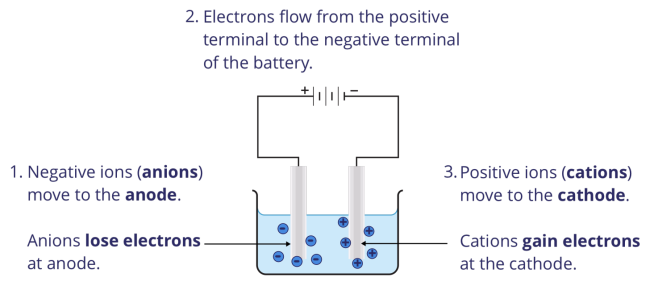
Consider the electrolyte as being an ionic compound in the molten or in aqueous solution, which contains mobile cations and anions.
During electrolysis, the anions are attracted to the positive electrode (anode), where they lose electrons to form atoms or molecules. We say that the anions are discharged. Oxidation has occurred at the anode.
The electrons flow to the positive terminal of the battery, then to the negative terminal before entering the electrolyte through the cathode.
At the negative electrode (cathode), the cations in the electrolyte are attracted to it, where they receive/gain electrons to also form atoms or molecules. The cations are discharged. Reduction has occurred at the cathode.
Electricity is, thus, conducted in two ways in the electrolytic cell:
- by the flow of electrons in the conducting wire in the external circuit,
- by the flow of mobile cations and anions in the electrolyte.
Question 1:
Electric currents are carried through electrolytes by the movement of __________.
- positive ions
- negative ions
- electrons
- positive ions and negative ions
Solution:
(4) positive ions and negative ions
Explanation:
Electrolytes are substances that contain mobile ions when molten or in aqueous solution. Hence, the conduction of electricity in the electrolyte is by the movement of the ions (cations and anions).
Evidence For The Existence Of Mobile Ions In Lattice
Electrolysis provides evidence for the presence of ions in ionic compounds, and that these ions are mobile when the compound is in molten state or in aqueous solution.
In the given figure on the left, solid sodium chloride is used, with two inert electrodes inserted into it and connected to a battery and a light bulb. It is observed that the light bulb does not light up and no products are formed at the electrodes. This is because the oppositely charged ions are held at the fixed positions in the ionic lattice, hence they are not mobile. No electric current flows through the circuit.

Now, when the solid sodium chloride is heated until it melts, the light bulb lights up. This is because the lattice structure of sodium chloride has been broken down and the oppositely charged ions are free to move about to conduct electricity. Electric current can flow through the circuit.
The same observations can be made when solid sodium chloride is dissolved in water to form an aqueous solution.
Question 2:
The diagram shows the apparatus used for an experiment on electrolysis.

Which of the following will make the bulb light up?
- replace graphite with platinum as electrodes
- heat lead(II) bromide until it melts
- use a higher power source
- add ethanol to lead(II) bromide
Solution:
(2) heat lead(II) bromide until it melts
Explanation:
When solid lead(II) bromide is heated until it melts, the lead(II) ions and bromide ions are free to move about to conduct electricity.
Question 3:
The table below shows the melting points of sulfur, lead(II) bromide and dilute sulfuric acid.
| Melting Point / ºc | Boiling Point / ºc | |
|---|---|---|
| Sulfur | 119 | 445 |
| Lead ( Ii ) Bromide | 370 | 910 |
| Dilute Sulfuric Acid | -2 | 102 |
When the apparatus is set up as shown below, the bulb glows.
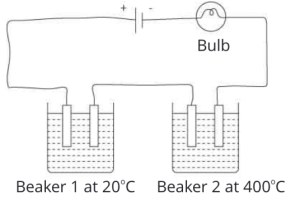
Which one of the following correctly describes the substances present in beaker 1 at 20ºC and beaker 2 at 400ºC respectively?
- Dilute sulfuric acid; Lead(II) bromide
- Dilute sulfuric acid; Sulfur
- Lead(II) bromide; Dilute sulfuric acid
- Sulfur; Lead(II) bromide
Solution:
(1) Dilute sulfuric acid; Lead(II) bromide
Explanation:
For the bulb to glow, there must be current flowing through the circuit. Thus, each beaker must contain an electrolyte. An electrolyte is a substance that contains mobile ions when molten or in aqueous solution.
Sulfur cannot be used as an electrolyte as it does not contain any mobile ions. Referring to the melting and boiling point of lead(II) bromide and dilute sulfuric acid, the substance in beaker 1 must be dilute sulfuric acid, while the substance in beaker 2 must be lead(II) bromide. This is because lead(II) bromide will be in the molten (or liquid) state at 400ºC, thus it contains mobile ions to conduct electricity.
Electrolysis Of Molten Binary Ionic Compounds
Binary ionic compounds are ionic compounds that consist of only two elements.
For Example:
| Ionic Compounds | Binary? (Yes/No) |
|---|---|
| PbBr2 | Yes |
| CuSO4 | No |
| MgO | Yes |
| Al2O3 | Yes |
| CaCO3 | No |
Electrolysis Of Molten Sodium Chloride
Let us study the electrolysis of molten sodium chloride (NaCl) using inert electrodes.
In the electrolyte, there are Na⁺ and Cl¯ ions that are mobile.
- At the cathode
- Na⁺ ions are attracted to it.
- Na⁺ ions are discharged by gaining electrons to form Na atoms. Na⁺ ions are reduced.
\(\textsf{Na⁺ (l) + e¯} \xrightarrow{\qquad} \textsf{Na (l)}\)
- We will observe a silvery sodium metal deposit at the cathode.
- At the anode
- Cl¯ ions are attracted to it.
- Cl¯ ions are discharged by losing electrons to form Cl2 gas. Cl¯ ions are oxidized.
\(\textsf{2Cl¯ (l)} \xrightarrow{\qquad} \textsf{Cl}_2\textsf{ (g) + 2e¯}\)
- We will observe a pale greenish gas at the anode.
To construct the overall chemical equation from the half equations:
We need to ensure that the electrons gain and loss must be conserved.
\(\begin{align} \{\textsf{ Na+ (l) + e¯} &\xrightarrow{\qquad} \textsf{Na (l) } \}\textsf{ × 2} \tag{1} \\[3ex] \textsf{2Cl¯ (l)} &\xrightarrow{\qquad} \textsf{Cl}_2\textsf{ (g) + 2e¯} \tag{2} \end{align}\)
Combine the left species and right species together.
\(\small{\textsf{2Na⁺ (l) + 2Cl¯ (l) + 2e¯} \xrightarrow{\qquad} \textsf{2Na (l) + Cl}_2 \textsf{ (g) + 2e¯}}\)
Cancelling the same species 2e¯ from both sides of the equation, we get:
\(\textsf{2Na⁺(l) + 2Cl¯ (l)} \xrightarrow{\qquad} \textsf{2Na (l) + Cl}_2\textsf{ (g)}\)
Question 4:
The diagram below shows an electrolytic setup.
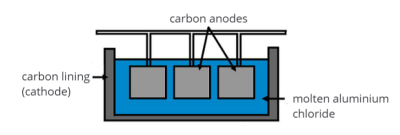
What are the products at the electrodes?
| Cathode | Anode | |
|---|---|---|
| (1) | aluminium | oxygen |
| (2) | aluminium | chlorine |
| (3) | hydrogen | oxygen |
| (4) | hydrogen | chlorine |
Solution:
(2) aluminium chlorine
Explanation:
Ions present in the electrolyte: Al³⁺and Cl¯ ions
The Al³⁺ ions will be attracted to the cathode (negative electrode) and be discharged by gaining electrons to form aluminium metal.
\(\textsf{Al³⁺ (l) + 3e¯}\xrightarrow{\qquad} \textsf{Al (s)}\)
The Cl¯ ions will be attracted to the anode (positive electrode) and be discharged by losing electrons to form chlorine gas.
\(\textsf{2Cl¯ (l)}\xrightarrow{\qquad} \textsf{Cl}_2\textsf{ (g) + 2e¯}\)
Conclusion
This article gave an introduction to what electrolysis is and the components to the electrolytic cell. Through the example of the electrolysis of molten sodium chloride using inert electrodes, we see how electrolysis works to decompose the electrolyte into sodium metal and chlorine gas by reduction and oxidation of the ions respectively. Diagrams and chemical equations have been included to enable the students to understand the concepts easily and quickly.
Bookmark the article so that you can easily come back to revise the concepts.
| Continue Learning | |
|---|---|
| Metals | Introduction to Organic Chemistry |
| Alcohols | Speed of Reaction |
| Electrolysis | Energy Changes |
| Ammonia | Alkanes |
| Alkenes | Carboxylic Acids |
 SG
SG  VN
VN 
